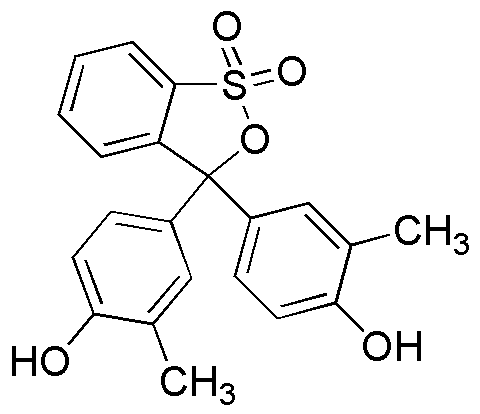Cresol red is widely utilized in research focused on:
- pH Indicator: Commonly used in laboratories to measure pH levels in various solutions, providing a clear color change that helps researchers determine acidity or alkalinity.
- Biological Staining: Employed in histology and microbiology for staining tissues and cells, aiding in the visualization of structures under a microscope.
- Environmental Testing: Used in assessing water quality by indicating the pH of samples, which is crucial for monitoring aquatic ecosystems and ensuring safe drinking water.
- Pharmaceutical Development: Acts as a pH-sensitive dye in drug formulation studies, helping scientists understand how drugs behave in different pH environments, which is vital for effective delivery.
- Educational Purposes: Frequently included in chemistry education to demonstrate acid-base reactions and the concept of pH, making it a valuable tool for teaching students about chemical properties.
General Information
Properties
Safety and Regulations
Applications
Cresol red is widely utilized in research focused on:
- pH Indicator: Commonly used in laboratories to measure pH levels in various solutions, providing a clear color change that helps researchers determine acidity or alkalinity.
- Biological Staining: Employed in histology and microbiology for staining tissues and cells, aiding in the visualization of structures under a microscope.
- Environmental Testing: Used in assessing water quality by indicating the pH of samples, which is crucial for monitoring aquatic ecosystems and ensuring safe drinking water.
- Pharmaceutical Development: Acts as a pH-sensitive dye in drug formulation studies, helping scientists understand how drugs behave in different pH environments, which is vital for effective delivery.
- Educational Purposes: Frequently included in chemistry education to demonstrate acid-base reactions and the concept of pH, making it a valuable tool for teaching students about chemical properties.
Documents
Safety Data Sheets (SDS)
The SDS provides comprehensive safety information on handling, storage, and disposal of the product.
Product Specification (PS)
The PS provides a comprehensive breakdown of the product’s properties, including chemical composition, physical state, purity, and storage requirements. It also details acceptable quality ranges and the product's intended applications.
Certificates of Analysis (COA)
Search for Certificates of Analysis (COA) by entering the products Lot Number. Lot and Batch Numbers can be found on a product’s label following the words ‘Lot’ or ‘Batch’.
*Catalog Number
*Lot Number
Certificates Of Origin (COO)
This COO confirms the country where the product was manufactured, and also details the materials and components used in it and whether it is derived from natural, synthetic, or other specific sources. This certificate may be required for customs, trade, and regulatory compliance.
*Catalog Number
*Lot Number
Safety Data Sheets (SDS)
The SDS provides comprehensive safety information on handling, storage, and disposal of the product.
DownloadProduct Specification (PS)
The PS provides a comprehensive breakdown of the product’s properties, including chemical composition, physical state, purity, and storage requirements. It also details acceptable quality ranges and the product's intended applications.
DownloadCertificates of Analysis (COA)
Search for Certificates of Analysis (COA) by entering the products Lot Number. Lot and Batch Numbers can be found on a product’s label following the words ‘Lot’ or ‘Batch’.
*Catalog Number
*Lot Number
Certificates Of Origin (COO)
This COO confirms the country where the product was manufactured, and also details the materials and components used in it and whether it is derived from natural, synthetic, or other specific sources. This certificate may be required for customs, trade, and regulatory compliance.


